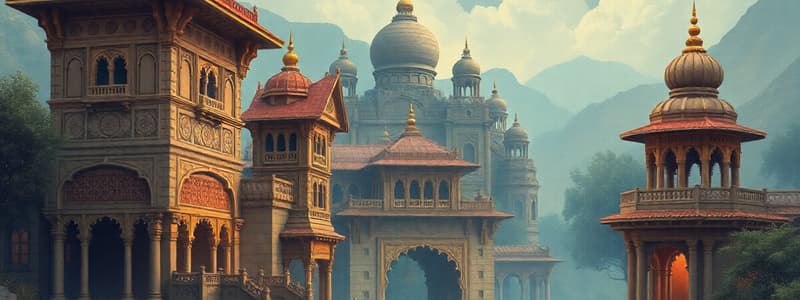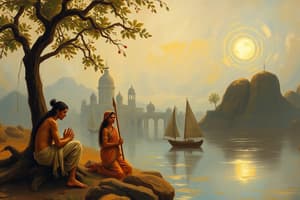Podcast
Questions and Answers
What role does Vishnu serve in Hinduism?
What role does Vishnu serve in Hinduism?
- The Teacher
- The Destroyer
- The Creator
- The Preserver (correct)
Which of the following best describes the origin of Hinduism?
Which of the following best describes the origin of Hinduism?
- It evolved from a blend of various beliefs and practices. (correct)
- It is a modern religion with no historical roots.
- It originated solely from Harappan beliefs.
- It was founded by Siddharta Gautama.
What does Nirvana represent in Buddhism?
What does Nirvana represent in Buddhism?
- A devotional practice
- A physical reincarnation
- A blissful state free of all desires (correct)
- A higher realm of gods
What are Viharas in the context of Buddhism?
What are Viharas in the context of Buddhism?
Which of the following symbols represents the Buddha in early Buddhist art?
Which of the following symbols represents the Buddha in early Buddhist art?
What does the term 'Stupa' refer to in Buddhist culture?
What does the term 'Stupa' refer to in Buddhist culture?
Who was Siddharta Gautama?
Who was Siddharta Gautama?
What distinct feature of the Dancing Lord Shiva Nataraja is highlighted?
What distinct feature of the Dancing Lord Shiva Nataraja is highlighted?
What process must Hindus aim to achieve with Brahma?
What process must Hindus aim to achieve with Brahma?
What is a key aspect of meditation in Buddhism?
What is a key aspect of meditation in Buddhism?
Flashcards
Harappan Civilization
Harappan Civilization
One of the oldest civilizations in the world, alongside Mesopotamia and Ancient Egypt, known for its developed systems and urban planning in the Indus Valley (modern-day Pakistan and India).
Harappans
Harappans
The settlers of the Indus Valley Civilization, who created advanced systems such as agriculture, urban planning, and trade.
Aryans
Aryans
Warrior shepherds who relied heavily on cattle or sheep for their livelihood. They were known for their nomadic lifestyle and played a significant role in shaping the cultural and religious landscape of India.
Hinduism
Hinduism
Signup and view all the flashcards
Brahma
Brahma
Signup and view all the flashcards
Vishnu
Vishnu
Signup and view all the flashcards
Shiva
Shiva
Signup and view all the flashcards
Siddharta Gautama (Buddha)
Siddharta Gautama (Buddha)
Signup and view all the flashcards
Viharas
Viharas
Signup and view all the flashcards
Stupa
Stupa
Signup and view all the flashcards
Study Notes
Ancient Indian Civilizations
- India is one of the earliest civilizations, alongside Mesopotamia and Ancient Egypt.
- Harappan Civilization emerged in the Indus Valley (modern-day Pakistan and India).
- Harappans developed advanced systems comparable to those of Egypt.
- Mohenjo-Daro, a city in the Indus Valley, existed around 2500 BCE.
Indian Art and Culture
- The Aryans, warrior shepherds, integrated with Harappan beliefs to form Hinduism.
- Hinduism is an ancient religion developed over time from a blend of beliefs and practices.
- Hinduism focuses on the three primary processes of creation, preservation, and destruction (Brahma, Vishnu, and Shiva).
- Buddhism was founded by Siddhartha Gautama.
- Siddhartha Gautama's holiness garnered widespread acclaim across India.
- Buddhists practice meditation, which focuses thoughts on a single object or idea, without praying to a higher being.
- Reincarnation is a process in both Hinduism and Buddhism, where souls are believed to live in many bodies over many lives.
- Hinduism aims for union with Brahma.
Buddhist Architecture
- Viharas are Buddhist monasteries.
- Early Viharas were simple wooden structures or cave shelters for wandering monks during rainy seasons.
- Stupas are small round burial shrines built over grave sites containing Buddha relics.
- Stupas promote opportunities for meditation, a significant part of Buddhist ideology.
Symbolism in Buddhist Art
- The presence of Buddha in Buddhist art is implied by symbols.
- Empty thrones
- Bodhi trees (trees where Buddha meditated)
- Footprints were depicted as symbols.
Buddhist Sculptures
- Early Buddhist sculptures showed scenes from Buddha's life.
- Buddha was not depicted directly, instead symbols were used – an example of a wheel placed on an empty throne represented the circle of life, maturity and death.
Symbolism in Indian Art (Shiva Nataraja)
- Shiva Nataraja, the Dancing Lord, is a significant figure.
- Multiple arms portray divine graceful movement while holding various objects.
- A drum symbolizes creation.
- Flame signifies destruction.
- An uplifted hand protects the faithful, while a pointed foot symbolizes escape from ignorance.
Rangoli
- Rangoli is a traditional Indian art form.
- Created by patterns on floors and walls to adorn homes & temples using materials like colored rice, dry flour, colored sand, or flower petals.
- Created commonly during the Diwali festival.
Taj Mahal
- The Taj Mahal is a famous monument in India.
Studying That Suits You
Use AI to generate personalized quizzes and flashcards to suit your learning preferences.




